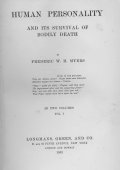 |
 |
| Click here for the PF Lyceum Site Index
  by Edward F. Kelly, Emily Williams Kelly, Adam Crabtree, Alan Gauld, Michael Grosso and Bruce Greyson (to be published by Rowman & Littlefield in November) Edward F. Kelly, PhD  The central purpose of this book is to update and re-evaluate the seminal contributions of Frederic W. H. Myers and William James in light of the subsequent century of work in scientific psychology. (For a bibliography of papers about Myers, click here.) The central purpose of this book is to update and re-evaluate the seminal contributions of Frederic W. H. Myers and William James in light of the subsequent century of work in scientific psychology. (For a bibliography of papers about Myers, click here.)  Its main conclusion is that Myers, James, and their colleagues in psychical research were well on their way towards constructing a correct overall picture of the nature of the human psyche — a picture, moreover, which naturally accommodates a variety of empirical phenomena that are difficult or impossible to explain in the context of conventional reductionist-materialist accounts of mind/brain relations. (The photo above left is the famous portrait of Frederic Myers taken by his wife, the photographer, Eveleen Tennant Myers. The photo above right is of William James.) Its main conclusion is that Myers, James, and their colleagues in psychical research were well on their way towards constructing a correct overall picture of the nature of the human psyche — a picture, moreover, which naturally accommodates a variety of empirical phenomena that are difficult or impossible to explain in the context of conventional reductionist-materialist accounts of mind/brain relations. (The photo above left is the famous portrait of Frederic Myers taken by his wife, the photographer, Eveleen Tennant Myers. The photo above right is of William James.)
Although we have made liberal use of parapsychological findings, our book in not about parapsychology per se. Rather, it treats the phenomena of parapsychology as just one of a larger set of interrelated psychological phenomena all of which point in this same theoretical direction. Topics reviewed in depth include phenomena of extreme psychophysical influence (such as stigmata, and hypnotically-produced blisters), memory, psychological automatisms and secondary streams of consciousness, near-death and out-of-body experiences, genius-level creativity, and the world-wide family of “mystical” experiences. We show that in all these areas the views of Myers and James have been sustained and reinforced by subsequent empirical observations, and in a concluding chapter we further show that the overall theoretical framework they developed can be reconciled with leading-edge physics and neuroscience. (For a descriptive listing of the Table of Contents, click here.)  The book occupies a unique position within the already large and rapidly burgeoning literature on consciousness and mind/body issues. Although philosophically informed, it is driven primarily by empirical evidence rather than conceptual analysis. In addressing its central scientific issues, it systematically brings to bear a wider range of evidence, and a longer historical perspective, than any related book of which we are aware. In sharp contrast with other recent books on mind and brain, nearly all of which presume the conventional “production” model — that all aspects of mind and consciousness are generated by physical processes occurring in brains — we reject this orthodox view in favor of the “transmission” or “filter” model introduced over a century ago by thinkers such as Myers, James, and Henri Bergson. (The photo to the left above is of Henri Bergson.) The book occupies a unique position within the already large and rapidly burgeoning literature on consciousness and mind/body issues. Although philosophically informed, it is driven primarily by empirical evidence rather than conceptual analysis. In addressing its central scientific issues, it systematically brings to bear a wider range of evidence, and a longer historical perspective, than any related book of which we are aware. In sharp contrast with other recent books on mind and brain, nearly all of which presume the conventional “production” model — that all aspects of mind and consciousness are generated by physical processes occurring in brains — we reject this orthodox view in favor of the “transmission” or “filter” model introduced over a century ago by thinkers such as Myers, James, and Henri Bergson. (The photo to the left above is of Henri Bergson.)
 In essence, the centennial of Myers’s great 1903 book, Human Personality and Its Survival of Bodily Death provided us with an ideal opportunity to argue for a radical and long-overdue enlargement of scientific psychology, one that makes room for transpersonal and spiritual dimensions of the human psyche without sacrifice of scientific rigor (see the introduction to and an article about the book.) In effect, we have also shown that there is a scientifically sustainable middle ground between the warring fundamentalisms — both religious and scientific — that have dominated recent discussions of these matters. As an added dividend, our book includes a CD containing the complete 2-volume text of Human Personality itself, plus five of its most significant contemporary reviews. In essence, the centennial of Myers’s great 1903 book, Human Personality and Its Survival of Bodily Death provided us with an ideal opportunity to argue for a radical and long-overdue enlargement of scientific psychology, one that makes room for transpersonal and spiritual dimensions of the human psyche without sacrifice of scientific rigor (see the introduction to and an article about the book.) In effect, we have also shown that there is a scientifically sustainable middle ground between the warring fundamentalisms — both religious and scientific — that have dominated recent discussions of these matters. As an added dividend, our book includes a CD containing the complete 2-volume text of Human Personality itself, plus five of its most significant contemporary reviews.
For imformation on how to obtain your own copy of Irreducible Mind click here. *********** |
 |

|
 www. parapsychology. org |
||